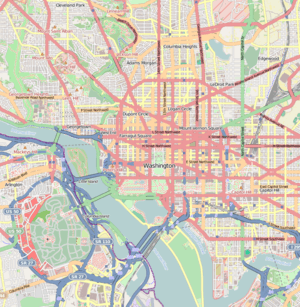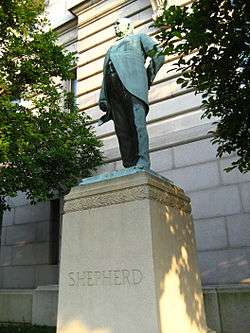John A. Wilson Building
|
District Building | |
|
| |
 | |
| Location |
1350 Pennsylvania Avenue, NW Washington, D.C. |
|---|---|
| Coordinates | 38°53′41″N 77°1′54″W / 38.89472°N 77.03167°WCoordinates: 38°53′41″N 77°1′54″W / 38.89472°N 77.03167°W |
| Area | 1.1 acres (0.45 ha) |
| Built | 1904 |
| Architectural style | Beaux Arts |
| Part of | Pennsylvania Avenue National Historic Site (#66000865[1]) |
| NRHP Reference # | 72001422[2] |
| Added to NRHP | March 16, 1972 |
The John A. Wilson District Building, popularly known simply as the Wilson Building, houses the municipal offices and chambers of the Mayor and District Council of the District of Columbia. Originally called the District Building, it was renamed in 1994 to commemorate former Council Chair John A. Wilson.[3] Completed in 1908, during the administration of 26th President Theodore Roosevelt, the building is a contributing structure to the Pennsylvania Avenue National Historic Site.
History
The original site of the John A. Wilson Building was a streetcar power station that had been destroyed by a fire in 1897. With the "Public Building Act" of 1902, the United States Congress authorized $550,000 for the purchase of the property and an additional $1.5 million (later increased to $2 million) dollars for the construction of a new District municipal building. Previously, the D.C. government had been housed in the old District of Columbia City Hall, a historic neoclassical styled structure on Indiana Avenue, constructed 1822-1849 by George Hadfield.[4]
A competition held for the design of the new District Building called for "classic design in the manner of the English Renaissance". The Philadelphia firm of Cope and Stewardson won the contract and construction started in 1904. The building was dedicated on July 4, 1908 by Henry MacFarland, President of the Board of Commissioners. While the building has continuously served as the municipal offices of the District's local government, the United States Department of War housed 200 visiting servicemen there during World War II.[4]
In 1977, a total of twelve gunmen took about 150 people hostage at three sites around Washington. During the crisis, later known as the 1977 Hanafi Siege, two of those gunmen held about a dozen hostages inside the council chambers on the fifth floor of the District Building. Then-councilman Marion Barry was hit by a stray bullet during the commotion, which left two others dead, including DC Protective Services Police Officer Wesley Cantrell. The press room at the Wilson Building is named in memory of Maurice Williams, a 24-year-old reporter who was killed during the attack.[5]
In 1995, two-thirds of the Wilson Building was leased to the Federal government for a period 20 years due to the District's inability to pay for needed repairs. However, after the United States Congress approved funds for a major renovation, the District was able to regain use of the entire building. The offices of the mayor and council were temporarily relocated to One Judiciary Square while those repairs took place.[6] The fully renovated Wilson Building reopened in September 2001.[3]
Exterior

The District Building was designed in the American Beaux Arts classical revival style and takes up the entire block between 14th and 13 1/2th Streets NW, south of Pennsylvania Avenue across from Freedom Plaza. The base of the building is made of grey granite from Maine while the upper four stories are constructed of white marble from New York. The main entrance to the building features an eagle with outstretched wings surrounded by two sculptures representing "Justice" and "Law." The fifth (attic) story features alternating male and female sculptures of heroic figures that represent: sculpture, painting, architecture, music, commerce, engineering, agriculture, and statesmanship.[3]
In January 2005, the statue of Alexander Robey Shepherd, Governor of the District of Columbia from 1873 to 1874, was restored to its original location in front of the Wilson Building at the northwest corner. It had been removed in 1979 during the first year of Mayor Marion Barry's administration.[7][8]
Current use
Following the District of Columbia Home Rule Act, the appointed Mayor-Commissioner form of government was replaced by a locally elected Mayor of the District of Columbia and Council of the District of Columbia who maintain their offices within the Wilson Building. The D.C. Council chamber, committee rooms, and legislative staff offices are also located in the building.
In October 2006, the DC Commission on the Arts and Humanities opened the City Hall Arts Collection. Art pieces from a diverse group of D.C.-area artists are on public display throughout the building. Works include a glass casting by Michael Janis of the Washington Glass School; paintings by Felrath Hines (former chief conservator of the Hirshhorn Museum), Sylvia Snowden, and Mark Cameron Boyd; photographs by Alexandra Silverthorne, Harlee Little, and Max Hirshfeld; and sculpture by Jae Ko. The portrait of John A. Wilson on display at the main entrance is by renowned portrait painter Simmie Knox.[9]
Notes
- ↑ National Park Service (2008-04-15). "National Register Information System". National Register of Historic Places. National Park Service.
- ↑ National Park Service (2010-07-09). "National Register Information System". National Register of Historic Places. National Park Service.
- 1 2 3 "John A. Wilson Building / District Building". Cultural Tourism D.C. Retrieved 5 October 2011.
- 1 2 Ganschinietz, Suzanne. "District Building" (PDF). National Park Service. Retrieved 5 October 2011.
- ↑ Vargas, Theresa (12 March 2007). "'Some Things You Never Forget'". The Washington Post. Retrieved 5 October 2011.
- ↑ Williams, Vanessa (November 11, 1999). "D.C. Government Reclaims City Hall". The Washington Post. Retrieved November 2, 2011.
- ↑ H-Net Review: Alan Lessoff <ahlesso@ilstu.edu> on Historical Dictionary of Washington, D.C
- ↑ "Rimensnyder Asks for New Respect for Washington's 'Boss' Shepherd" in "Lecture Series" page of official website of The Ruth Ann Overbeck Capitol Hill History Project, Washington, D.C. Accessed August 5, 2008.
- ↑ Dawson, Jessica (11 November 2006). "In District Government Building, All Art Is Local". The Washington Post. Retrieved 5 October 2011.